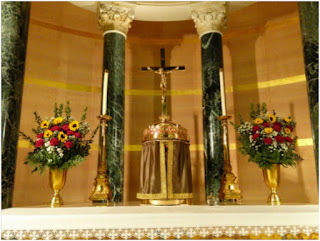Altar Flowers: A Beautiful Offering to God
In our Spirituality
class this semester, we read some of St Terese of Lisieux’s book, The Story of a Soul. Everyone knows her
as “The Little Flower,” because she saw herself as Jesus’ little white flower
and she speaks of nature, gardens, and all sorts of flowers often. St Terese
says, “[The Lord] opened the book of nature before me, I saw that every flower
He has created has a beauty of its own.” (Ch 1, par.4 ) Reading this, it
occurred to me that arranging the flowers for the altar has really helped me appreciate
this statement!
To prepare the altar flowers, I go to a large wholesale
flower distributor, where they have a huge walk-in cooler with hundreds of
flowers, greenery, and other plants. I usually buy three different kinds of
flowers and two types of green, leafy “filler” plants. While the store has a
huge selection, it is not the whole “book of nature.” Still, it can be
overwhelming to choose only a couple varieties when there are so many amazing
flowers available.
Back at the seminary, I unpack the flowers and put them
temporary vases, so they can open up and I can easily work with them. Unpacking
them is the first time you really get your hands on the flowers and their
stems, so you get a good feel for what you are working with – leaves or thorns,
thick stalks or thin stems, tender shoots or burly branches!
I begin to arrange the flowers for the altar by putting a
background of greenery in the vase first. Then, I place the “feature flowers”
in the vase evenly so they can all be seen. Next, I place some secondary
blossoms strategically in between the feature flowers. After that, I use
“filler flowers” to fill in any gaps in the arrangement. Lastly, I place
greenery around the sides and the front. That completes the process.
Preparing the altar flowers for the last two months has
opened my eyes to the amazing beauty and diversity of nature, as well as a new
richness of spirituality. Firstly, these flowers I am handling come from all
over the world: Ecuador, Colombia, Australia, Florida, Oregon, California, and
Texas. As I work with each flower, it gives me an opportunity to pray for the
country and the people who grow the flowers. This natural diversity reminds me
that the Catholic Church is worldwide and just as diverse as the flowers of
nature. Secondly, some the species of flowers are very delicate. I must be very
careful not to break the stem or damage the bloom as I am placing it in the
vase. A damaged flower is a waste of God’s creation because I cannot use it in
the arrangement. This reminds me to treat others with kindness and tenderness,
because each person has a dignity of their own, which must not be damaged or
wasted. Lastly, when the arrangement is complete, I put it on the altar and
step back to look at it. I no longer see a bunch of individual flowers, but a
single arrangement, a collage of colors, an artistic display. Every single
flower has disappeared, and in their place, a whole bouquet has emerged. In a
sense, the art of flower arranging is a kind of floral pointillism – that neo-impressionist style of painting that uses
only tiny dots of paint which the viewer’s eye blends together to produce a
whole image. Hopefully, my flower arrangements give glory to God and add to the
beauty of our chapel.
St Terese of Lisieux, pray for us.
Written by Nathan Davis, Seminarian for the Personal Ordinariate of the Chair of St. Peter





Thanks for giving us the opportunity for leaving comments, this made possible for us to share our social profiles with you. haute her for tips for girls
ReplyDeletealpaca blankets
ReplyDeleteeco cashmere blankets
wool pillows
Responsibly sourced. Sustainably made. Soulful with a story to tell. We work with artisan partners, small batch makers and ethical suppliers to create nature - inspired home decor. Textiles |Decorative Accessories | Botanicals | Vases | Planters | Scents + Candles